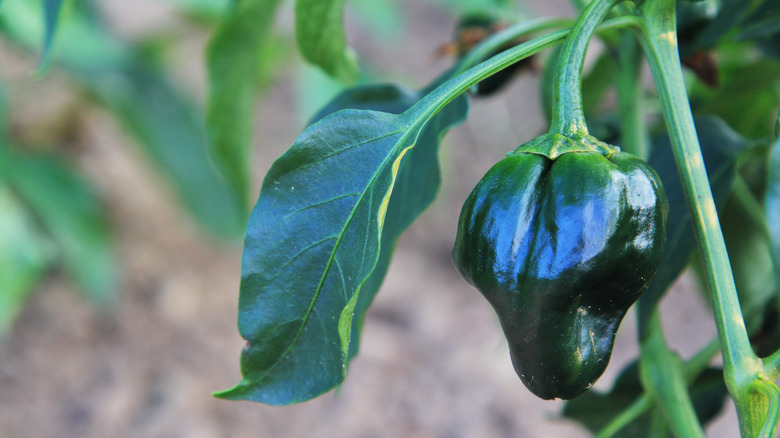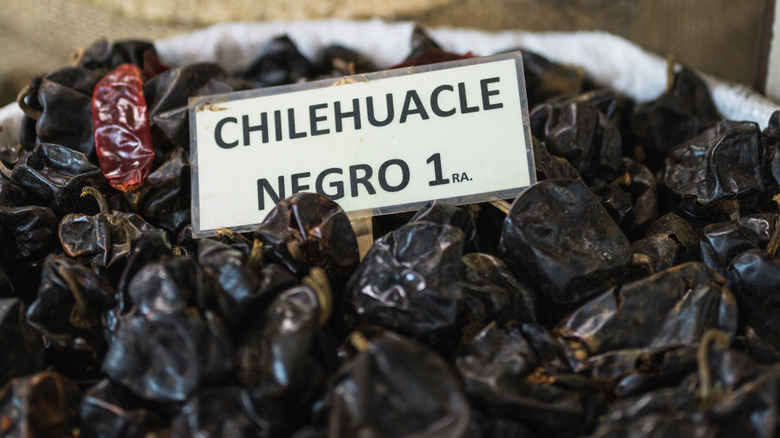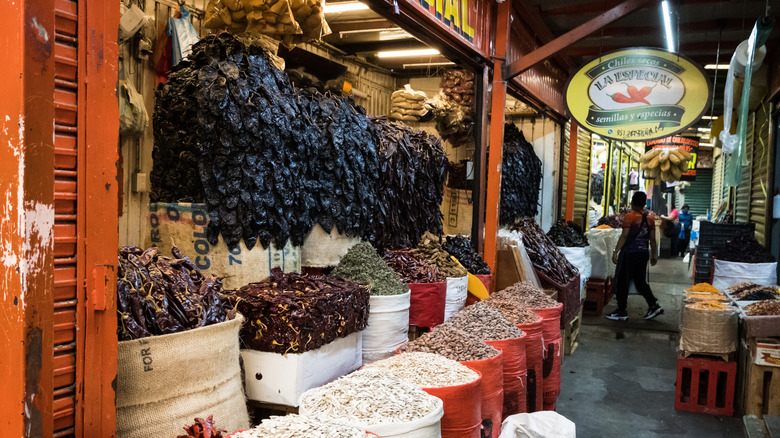The Most Expensive Chile In Mexico Comes From One Small Region
If you're in a Mexican market or bodega, and you happen to see a small, black dried pepper for sale called chilhuacle negro, check its price tag. If it costs under $100 per pound, you might consider buying some, because that's one seriously good deal. Mexican-grown dried chilhuacle chiles are often priced at over $200 per pound, though you can find solid discounts if you buy in bulk. You may think this is a pretty steep price, and you'd be right. Chilhuacle is currently the most expensive chile in Mexico and is, in fact, one of the most expensive spices in the world.
This pepper is used in traditional Oaxacan cooking, including a dish called mole negro, which is often eaten on the Day of the Dead. The chile's flavor has been described as smoky and spicy, with an initially sweet and tart taste. Mole negro is one of those Mexican foods you should try at least once in your life, but that's easier said than done. The chilhuacle pepper is not just pricy, but extremely rare as it's only grown in a select few areas of the Cañada region, Mexico. That prime chilhuacle territory isn't really flourishing, putting the pepper's future in danger.
Why chilhuacle peppers are worth their weight in gold
When exploring the world of chiles, you'll find that there are several types of chilhuacle, including rojo and amarillo varieties. Negro is the rarest. In the Cañada valley, where it's cultivated using ancient ancestral methods, the people consider the chile sacred and use it in numerous celebratory dishes. However, in the past few decades, the number of farmers producing chilhuacles has dwindled, leaving only seven remaining.
These farmers are faced with constant hardship because of environmental changes and particular cultivation methods. The chilhuacle negro is only grown in small plots, generally without modern fertilizers or pesticides, the farmers instead relying on growing techniques that are thousands of years old. Unfortunately, these methods don't account for massive increases in aphids, whiteflies, fungus, and other plant diseases that now plague the area. This means that, even under watchful care, it's hard not to lose large portions of the crop. Demand is still high, but yield is low, at only one tonne per planted hectare of land annually. The results are sky-high prices for locals and foreign foodies alike.
So, why don't more farmers grow this super lucrative crop? The fact is that it's easier and cheaper to grow other things. Mangoes in particular have become incredibly popular to grow in Oaxaca, a practice that has only brought more insect pests to the region, further isolating the peppers. Since they are mostly grown in one small area, they have decreased genetic diversity, making them susceptible to disaster.
Chilhuacle peppers have a flavor worth fighting for
While this pepper is in decline, that doesn't mean people aren't trying to combat its gradual disappearance. Some of the remaining farmers have begun learning from modern farming methods. Others give out chilhuacle seeds to farm visitors, in an attempt to spread the breed and keep it from dying out. There have been multiple studies about bacterial and fungal impacts on the chile, as well as which tending methods yield the best results. The chilhuacle negro may be a rare delicacy with a steep price tag, but the battle to save it goes on.
For those who want to help, be thoughtful with your purchasing. Some farms in the United States and Spain have begun to grow chilhuacles, but the resulting peppers are less flavorful and don't support the ancestral origins of the chile. If you do buy chilhuacle negros, try to purchase those grown in Oaxaca, so they can keep their traditional heritage alive.
If you don't have any direct access to them, you could try getting seeds from the region online and planting a few yourself. Seeds sold from Mexico often come at a reasonable $5-or-less price tag, so if you have the time and patience, consider giving them a shot. If you're looking to introduce yourself to Oaxacan food but you don't have a green thumb, just keep an eye open for this chile in markets or on menus, and be mindful of the price tag.


